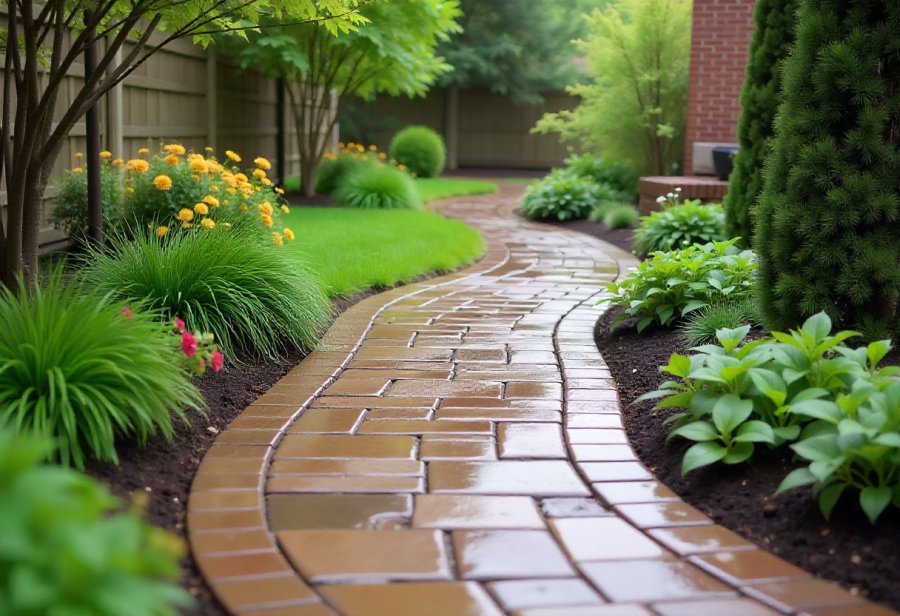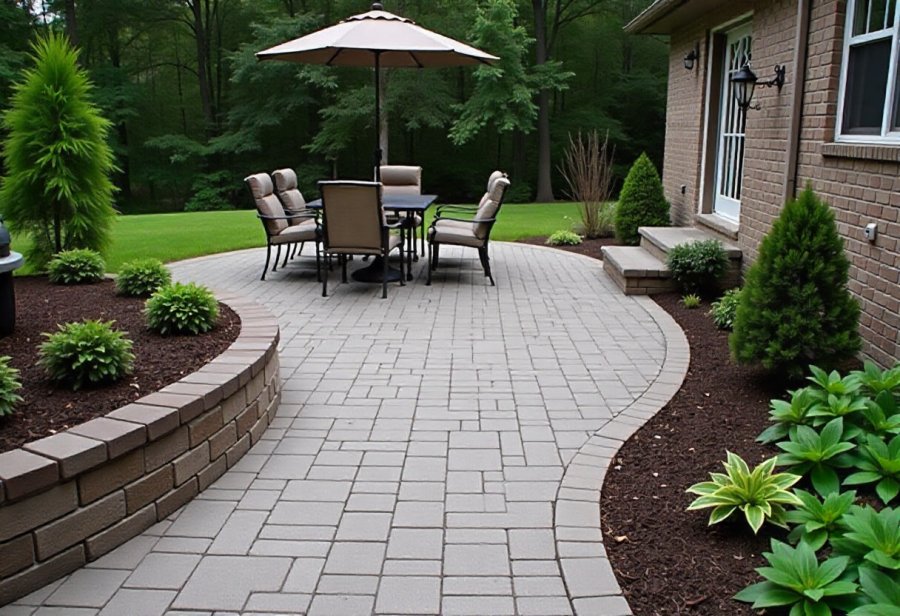Imagine transforming urban flood control with permeable pavers—are cities ready to turn rainwater into a sustainable resource rather than a hazard? As storms grow more intense and pavements expand, traditional impermeable surfaces like asphalt exacerbate flooding, overwhelming stormwater systems and threatening safety. Permeable pavers offer a promising solution by mimicking natural land absorption, allowing water to seep into the ground, filter pollutants, and recharge aquifers. But how do these eco-friendly surfaces function beneath the surface, ensuring durability while filtering contaminants? Their installation requires careful planning, from site assessment to layered construction and regular maintenance. Advancements in materials and smart monitoring systems promise even greater resilience, raising questions about how cities will adopt these innovations to combat climate change and urban sprawl. Will permeable paving become the new standard in sustainable urban design? This technology not only prevents flooding but reshapes our approach toward resilient, greener communities—yet the future of flood control depends on widespread awareness and application.

Transforming Urban Flood Control with Permeable Pavers
Urban flooding is becoming an increasingly urgent concern as cities face more intense storms and expanding concrete landscapes. Traditional paving materials like asphalt and concrete are designed to be impermeable, causing rainwater to run off surfaces quickly instead of seeping into the ground. This often leads to overwhelmed stormwater systems, street flooding, property damage, and daily safety hazards. As cities grow and weather patterns become more unpredictable, finding smarter ways to manage rainwater has never been more critical.
Permeable pavers offer a practical solution by allowing rainwater to naturally infiltrate the soil. These surfaces are made with porous materials or have gaps filled with gravel or sand, creating pathways for water to drain through during storms. Unlike conventional pavement, permeable pavers help reduce surface water pooling and lessen the burden on stormwater systems, making urban areas more resilient to flooding. Their design mimics natural land absorption, turning rain into a resource rather than a hazard.
Beyond flood mitigation, permeable pavers support healthier urban ecosystems. As water filters through these surfaces, pollutants like sediments, oils, and chemicals are captured and removed before reaching groundwater sources. This process not only improves water quality but also facilitates groundwater recharge, helping cities sustain their water supplies and protect local habitats. Incorporating these surfaces into cityscapes can transform gray, impermeable areas into functional, environmentally friendly spaces.
The aesthetic and community benefits of permeable paving are also notable. These surfaces blend seamlessly into parks, sidewalks, and plazas, creating attractive, green-friendly environments. They encourage outdoor activity, foster community pride, and promote a sense of environmental stewardship. As urban planners prioritize sustainable development, permeable pavers stand out as a versatile tool for building greener, more livable neighborhoods.
With climate change intensifying rainfall events and urban sprawl increasing impervious surfaces, the need for adaptable flood control solutions grows. Permeable pavers not only address current challenges but also prepare cities for future ones. They turn stormwater management into an opportunity for sustainable growth, helping communities stay dry, healthy, and resilient in an uncertain weather future. Embracing this technology is a smart step toward creating cities that are both functional and environmentally conscious.
Building Blocks of Permeable Paving Systems: Materials and Mechanisms
Permeable paving systems are built around the principle of allowing water to pass through their surfaces and reach the ground below. The success of these systems depends heavily on the choice of materials and how they’re assembled. Common options include permeable concrete, porous asphalt, and interlocking pavers designed with gaps filled with gravel or sand. These gaps aren’t just empty spaces; they’re engineered to maintain porosity, enabling water to flow freely during rainfall. This mimics natural land absorption, helping to reduce surface runoff and prevent pooling.
Beneath the surface, a supportive base layer is essential. Typically, a bed of compacted crushed gravel or aggregate provides stability while facilitating drainage. This layer acts as a conduit, directing water downward and preventing it from pooling on the surface. When rainwater hits the permeable surface, it seeps through the gaps and porous materials into these underlying layers. As water travels through gravel and soil, sediments and pollutants are filtered out, which improves water quality before it reaches groundwater sources.
Permeable pavers are versatile and suitable for various applications, from parking lots and driveways to walkways and public plazas. Their design handles significant water flow, making them an effective tool for stormwater management. Unlike traditional surfaces, these pavers support groundwater recharge and help maintain a healthier water cycle in urban environments. Their filtration capacity also captures and removes pollutants like oils and sediments, further benefiting environmental health.
Understanding permeability—the ease with which water passes through a surface—is key to designing effective systems. Porosity depends on the material’s properties and the size of the gaps between the pavers. Surfaces with high permeability allow water to flow quickly, while lower-permeability setups require careful planning. Proper installation of layers, materials, and gaps is crucial to ensure consistent water flow and prevent clogging. When installed correctly, permeable paving offers a durable, water-smart surface that actively manages rainwater and reduces runoff.
The engineering of permeable pavers involves precise manufacturing and installation techniques. Interlocking pavers are crafted to fit tightly, creating a stable yet porous surface. Filling gaps with gravel or sand must be done carefully to maintain porosity and prevent shifting. Support layers, including geotextile fabrics, help preserve the system’s integrity and prevent soil migration. Regular maintenance, such as sweeping to remove debris, keeps pores clear and ensures the system functions effectively over time. When properly installed and maintained, permeable paving becomes a resilient, water-conscious solution for urban flood control.

Environmental and Urban Benefits of Permeable Pavers: A Sustainable Solution
Permeable pavers offer a range of environmental and urban benefits that make them an increasingly popular choice for flood mitigation. Their ability to reduce flooding risks during heavy rains is perhaps their most immediate advantage. By allowing water to flow directly into the ground, these surfaces prevent water from pooling on streets and sidewalks, easing the strain on overwhelmed stormwater systems. This natural drainage process helps cities avoid costly infrastructure repairs and minimizes the risk of street flooding, making urban areas safer and more resilient.
Beyond just managing water, permeable pavers play a vital role in improving water quality. As rainwater filters through the porous layers, pollutants such as oils, sediments, and chemicals are captured and removed. This filtration process ensures cleaner water reaches underground aquifers and natural waterways, supporting healthier ecosystems and reducing contamination. Additionally, these surfaces facilitate groundwater recharge, replenishing vital water reserves that sustain both urban water supplies and natural habitats.
The impact on stormwater management infrastructure is significant. Traditional impervious surfaces contribute to rapid runoff, often causing backups and flooding during storms. Permeable paving slows this process, allowing for gradual infiltration and reducing the burden on drainage systems. This natural approach not only enhances resilience but also lowers maintenance costs and the need for extensive drainage infrastructure, making cities more adaptable to changing weather patterns.
Aesthetic and community benefits are also notable. Permeable pavers can be integrated into parks, walkways, and public plazas, transforming functional spaces into attractive, environmentally friendly environments. Their seamless blend with natural landscapes encourages outdoor activity and fosters a sense of community pride. As urban areas aim to become greener and more sustainable, permeable paving provides a practical way to enhance both the look and feel of neighborhoods.
In the face of climate change and expanding urban sprawl, the need for adaptable flood control solutions grows more urgent. Permeable pavers meet this challenge by effectively managing increased rainfall while supporting broader sustainability goals. They turn stormwater from a problem into an opportunity for ecological and infrastructural benefits, helping cities stay dry and healthy amid unpredictable weather events.
Overall, permeable pavers do more than just prevent flooding—they create healthier, more sustainable urban environments. Their capacity to filter pollutants, support groundwater recharge, and reduce runoff aligns perfectly with the goals of resilient, eco-conscious city planning. By embracing this technology, communities can build more vibrant, flood-resistant neighborhoods that are prepared for the challenges of tomorrow.
Implementing permeable pavers also contributes to urban biodiversity by creating more natural and inviting spaces for both humans and wildlife. For those interested in exploring more about sustainable urban design, learning about the benefits of permeable paving can provide valuable insights into creating resilient and eco-friendly communities.
Practical Guide to Installing and Maintaining Permeable Pavers for Optimal Performance
Installing permeable pavers effectively begins with thorough site assessment. Evaluating soil type, drainage capacity, and expected load helps determine the right materials and design approach. Proper excavation to the correct depth is essential, creating space for a stable foundation and drainage-supporting layers. Laying down a geotextile fabric prevents soil migration into the gravel base, maintaining permeability and structural integrity from the start.
A crushed gravel or aggregate base is then carefully installed and compacted to provide stability while promoting water flow. This layer acts as a conduit, guiding water downward and preventing surface pooling. When placing the pavers, ensure they are tightly fitted together in the chosen pattern, with gaps filled with gravel or sand to sustain porosity. After placement, thorough compaction locks everything into place, reducing the risk of shifting or uneven surfaces over time.
Maintenance is key to keeping permeable pavers functioning optimally. Regular sweeping clears debris that could clog pores, ensuring water can pass through freely. Periodically checking and refilling gaps with gravel or sand helps preserve porosity, especially after heavy storms or seasonal changes. Avoid sealing or using chemicals on the surface, as these can block pores and diminish water filtration. Consistent upkeep extends the lifespan of the system and preserves its flood mitigation benefits.
Too often, poor installation choices undermine system performance. Skipping the geotextile fabric or not excavating deep enough can lead to uneven settling and soil contamination of the gravel base. Using inappropriate fill materials, like fine soil or clay, risks clogging pores and reducing permeability. Not fitting pavers tightly or leaving gaps too wide can cause shifting, affecting both appearance and function.
Attention to detail during installation makes all the difference. Each layer must be carefully prepared and installed following manufacturer guidelines to ensure the system remains porous and durable. Proper compaction at each stage provides stability, while meticulous gap filling promotes consistent water flow. After installation, routine inspections and maintenance prevent clogging and ensure efficient drainage, making the system a reliable tool for urban flood control.
When installed correctly and maintained regularly, permeable pavers offer a resilient, water-smart surface that actively manages rainwater. They reduce runoff, support groundwater recharge, and help cities adapt to heavier rainfall and climate shifts. This thoughtful approach turns a complex challenge into an opportunity for smarter, sustainable urban spaces that stay functional and environmentally friendly for years to come.
Transform Your Outdoor Space with Expert Landscaping in Toronto
Discover the difference with Toronto Landscape & Design, your premier choice for professional landscaping in Toronto. Our award-winning designers specialize in creating stunning natural stone features, water gardens, irrigation systems, and retaining walls that elevate your property’s beauty and functionality. We take a comprehensive approach, considering every detail to ensure your landscape is both beautiful and sustainable. Whether you’re redesigning your backyard or enhancing your commercial space, Toronto Landscape is committed to delivering exceptional results tailored to your vision. Contact us at https://TorontoLandscapeDesign.com or call 1.416.644.0499 to start transforming your outdoor environment today.

Innovating for the Future: Advances and Reflections on Permeable Paver Technologies
Looking ahead, innovations in permeable paving are set to make flood control even more effective and adaptable. Researchers are developing new materials that are more durable, environmentally friendly, and capable of withstanding heavy traffic and harsh weather conditions. These advancements will prolong the lifespan of permeable surfaces and reduce maintenance costs, making widespread adoption more practical and appealing. At the same time, smarter drainage systems equipped with sensors and IoT technology are emerging. These systems can monitor water flow in real time, allowing cities to respond dynamically during storms and optimize water management efforts actively.
Urban planners and policymakers are increasingly embracing sustainable infrastructure, which bodes well for permeable paving solutions. Many cities are setting ambitious targets to incorporate permeable surfaces in public spaces, parking lots, and residential developments. Incentives and regulations are encouraging builders to prioritize water-smart designs, accelerating the shift toward greener urban landscapes. As these policies take hold, the adoption of permeable pavers is likely to grow, transforming cityscapes into more resilient, environmentally conscious environments.
Design and manufacturing innovations also make permeable pavers easier to install and maintain. Modular systems are gaining popularity, reducing barriers for communities to implement them. Improvements in production techniques result in pavers with tighter interlocking and better porosity, ensuring consistent performance over decades. These technical advances make permeable paving a reliable, scalable solution adaptable to various climates and usage levels, supporting a broader range of urban and suburban projects.
Lessons from current projects highlight the importance of proper planning and ongoing maintenance. When installed correctly and cared for regularly, permeable pavers effectively reduce flooding, support groundwater recharge, and improve water quality for years. Future developments should focus on simplifying maintenance and increasing system resilience, enabling communities to maximize flood mitigation benefits without significant operational costs. These efforts will help establish permeable paving as a standard component of sustainable urban infrastructure.
As climate change continues to bring more unpredictable weather and heavier storms, the need for adaptive, water-smart solutions becomes even more urgent. Permeable surfaces offer a natural, flexible way to manage increased water volumes, helping communities stay dry and safe amid extreme weather events. Embracing new technologies and innovative designs now will better prepare cities for these challenges, turning stormwater from a threat into an opportunity for smarter, greener development.
The progress made so far underscores that permeable pavers are a vital part of building resilient cities. Their ability to reduce runoff, filter pollutants, and support groundwater recharge aligns with broader sustainability and urban health goals. As innovation accelerates and adoption expands, permeable paving can become a foundational element in creating cities that are not only flood-resistant but also more vibrant and environmentally conscious. The future depends on continuous research, supportive policies, and active community engagement to turn these promising solutions into everyday practice, ensuring healthier, safer neighborhoods for generations to come.






